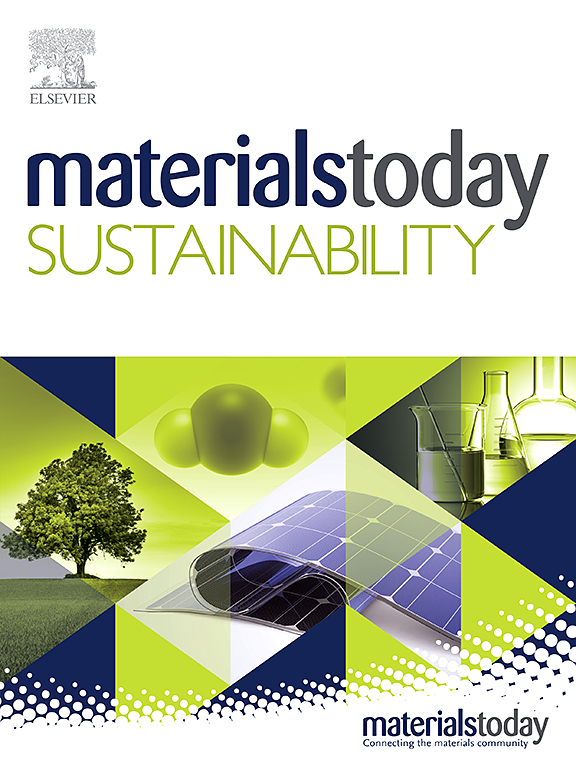生物质/煤/CaO共炭化法制备碳基合成燃料及其燃烧行为
IF 7.1
3区 材料科学
Q1 GREEN & SUSTAINABLE SCIENCE & TECHNOLOGY
引用次数: 0
摘要
据报道,一种环保、低成本的共碳化技术是制备用于钢铁工业烧结工艺的碳基合成燃料的有效途径,该技术中负载的CaO催化剂促进了锯末(SD)和烟煤(BC)之间的协同作用。本文通过一系列实验研究了共碳化温度、共碳化保温时间和CaO添加量对合成燃料性能的影响。最后,以生物质/煤4/6为基础,共炭化温度550℃,共炭化保温时间30 min, CaO添加量4 wt%为合理制备条件。根据上述实验参数,SD/BC合成燃料的固体产率为61.07%,容重为403 kg m−3,热值为27.82 MJ kg−1。结果表明,CaO的加入提高了合成燃料微晶的有序度和密度。在表面结构上,CaO的加入提高了芳香族CC和C-O的含量,而羰基CO的含量在炭化过程中下降,说明CaO的加入促进了类石墨结构的转变。此外,与未加载CaO相比,加载CaO的SD/BC合成燃料表面更粗糙,孔隙更大,孔隙数量减少,因为CaCO3的形成包裹在合成燃料表面。本研究得到的碳基合成燃料的上述指标符合烧结作业的实际要求。本研究揭示了生物质/煤与CaO相互作用制备碳基合成燃料的机理。本文章由计算机程序翻译,如有差异,请以英文原文为准。

Preparation and combustion behavior of carbon-based synfuel from biomass/coal/CaO by co-carbonization process
An environmentally friendly and low-cost co-carbonization technology has been reported as an effective route for the preparation of carbon-based synfuel for sintering processes employed in the steel industry, in which loaded CaO catalysts promote the synergistic role between sawdust (SD) and bituminous coal (BC). In this work, a series of experiments were conducted to research the effects of the co-carbonization temperature, co-carbonization holding time and addition amount of CaO on synfuel. Finally, a co-carbonization temperature of 550 °C, a co-carbonization holding time of 30 min, and the added amount of CaO at 4 wt% were reasonable preparation conditions based on the biomass/coal of 4/6. According to the above experimental parameters, the solids yield, bulk density and heat value of SD/BC synfuel were 61.07%, 403 kg m−3 and 27.82 MJ kg−1, respectively. These results showed that adding CaO increases the order and density of synfuel microcrystals. For the surface structure, the addition of CaO could improve the content of aromatic C![]() C and C–O, whereas the content of carbonyl C
C and C–O, whereas the content of carbonyl C![]() O decreased in the carbonization process, which demonstrated that the addition of CaO could improve transformation of the graphite-like structure. Additionally, SD/BC synfuel loaded with CaO exhibited a rougher surface and larger pores compared to that without CaO loading, and the number of pores decreased because the formation of CaCO3 coated the synfuel surface. The above indicators of carbon-based synfuel obtained from this study agree with the practical requirements of sintering operations. This work reveals the mechanism of biomass/coal and CaO interaction on the preparation of carbon-based synfuel.
O decreased in the carbonization process, which demonstrated that the addition of CaO could improve transformation of the graphite-like structure. Additionally, SD/BC synfuel loaded with CaO exhibited a rougher surface and larger pores compared to that without CaO loading, and the number of pores decreased because the formation of CaCO3 coated the synfuel surface. The above indicators of carbon-based synfuel obtained from this study agree with the practical requirements of sintering operations. This work reveals the mechanism of biomass/coal and CaO interaction on the preparation of carbon-based synfuel.
求助全文
通过发布文献求助,成功后即可免费获取论文全文。
去求助
来源期刊

Materials Today Sustainability
Multiple-
CiteScore
5.80
自引率
6.40%
发文量
174
审稿时长
32 days
期刊介绍:
Materials Today Sustainability is a multi-disciplinary journal covering all aspects of sustainability through materials science.
With a rapidly increasing population with growing demands, materials science has emerged as a critical discipline toward protecting of the environment and ensuring the long term survival of future generations.
 求助内容:
求助内容: 应助结果提醒方式:
应助结果提醒方式:


